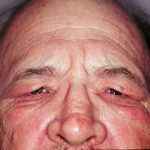As one ages, many facial structures fall unless they are rigidly fixed to bone. One of these falling structures is that of the eyebrows. Normally the eyebrows are situated either directly in front of or slightly above the level of the supraorbital ridge bone. But with time, gravity and expressive movements, the brows may slide off of the bone and push down on the eyelids. This creates a low brow position which leads to a tired or angry appearance and makes the upper eyelid skin look more redundant and full.
Browlifting is always an option in periorbital rejuvenation surgery which is often combined with eyelid tucks or blepharoplasty surgery. Browlift surgery is unique, similar to a facelift, in that the lifting is done from a superior and far away location to keep scars hidden either at (pretrichial browlift) or within the scalp hair. (coronal or endoscopic browlift) But there is an alternative browlift option that is actually the most effective of all the available techniques, that of a direct or external browlift.
The external browlift or browpexy is where the eyebrows are lifted directly through direct skin excision along the upper edge of the eyebrow hairline. It is very effective because its lifting effect is directly at the eyebrow, thus creating a 1:1 ratio between skin removed and the amount of eyebrow lift. While this is far easier and more effective than any distant browlift technique, the issue is the visbility of the scar…a majoir concern in any cosmetic procedure where other options do exist.
In a recent 2012 issue of Ophthalmic Plastic and Reconstructive Surgery, a paper was published on a single surgeon’s experience with the external browpexy technique. Over a two year period, a total of 28 patients had the procedure of which the average age was 62 years old. (age range from 51 to 76 years of age) Eighteen of the patients were men (64%) with most of the patients having bilateral browlift procedures. The results of the scars were judged as good by patient satisfaction, all with the exception of a single scar. The author concludes that the exterbal browpexy is a straightforward procedure that produces high levels of patient satisfaction. The brow incision heals well without a perceptible scar in most cases and provides a reliable method of elevating the temporal brow. It is a good adjunct to enhancing upper blepharoplasty outcomes.

Dr. Barry Eppley
Indianapolis, Indiana



